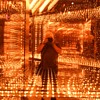Posted 6 years ago
 rniederman
rniederman
(350 items)
My recent post about a postage stamp sized tintype started a discussion about daguerreotype and tintype images that are laterally reversed (flipped left-to-right). It’s a really interesting topic and I thought to share some information about reversed images and attempts to overcome the problem. Comments by “scottvez” on my tintype post provide great insights to help collectors better understand, more specifically for example, Civil War and other images in which signs and letters are reversed. Anyhow, I feel this is a good post to continue that discussion.
As background, collectors notice numerous early images - especially daguerreotypes and tintypes with signs and letters - are reversed left-to-right while other pictures are oriented correctly. Why does this happen?
The reason has to do with early photographic processes that do not use negatives. Processes such as daguerreotypes and tintypes create one-of-a-kind images directly on a metal plate. The images are reversed because the projected scene is actually on the side of the plate facing the lens. When composing, the photographer is looking at the scene from the other side of the focusing glass. Otherwise, look through a magnifying glass or camera lens and your eye sees a scene that is upside-down and backwards. This is how all image capturing materials record a scene (including digital cameras!).
Even when a picture is flipped vertically, so that the top of a scene is at the top of the image, everything (i.e. people, buildings, letters, signs, etc.) remains laterally reversed (left-to-right). The problem is solved with later photographic processes using paper, glass and film for negatives; they are flipped in the printing frame (or viewing frame for ambrotypes) and the image becomes laterally correct. When prints are made, lettering on signs, war insignia (etc.) now look normal.
The reversing problem was recognized early on and one way to reorient images was to make photographic copies. However the quality of copied images is not as good as originals. Another way to solve the problem was the invention of a clever accessory that laterally reversed the scene ahead of the camera’s lens. These gadgets (so to speak) were mirrors or prisms positioned at 45 degrees in front of the cameras lens. This meant that the photographer needed to set up the camera at a right angle (90 degrees) to the subject (person, building, etc.).
Somewhere in my library are ephemera with illustrations of reversing devices, but I feel this posted image is a great representation of the actual equipment used by early photographers. Please note the picture is not mine and copied from page three of an article entitled “Daguerreian Apparatus in the Spira Collection” (© 1993 S.F. Spira, Whitestone, New York 11357, U.S.A. Research by Nigel H. Russell).
The picture shows a very early 1842 daguerreotype outfit by Richebourg. The camera has a reversing mirror mounted on the front of the lens. The picture’s caption reads: “From left to right: sensitizing box, developing box, plate box, small and large Voigtländer lenses, plate vise, camera with Richebourg lens and reversing mirror, plate-holder with reducing back and three frames.”
Because camera setup and aligning (orienting) the image for a nice composition was cumbersome, reversing mirrors and prisms were seldom used and today are extremely rare collectables. In nearly 30 years of collecting, two have appeared for sale. Maybe one day I will be fortunate enough to acquire one of these accessories.

















Thank you for the background info on early photography, fascinating stuff!
Thanks, bobby725!
Thanks!
Newfld
Vynil33rpm
GREAT posting rob!
Thanks for taking the time to add the information/ photos.
scott
Thanks!
Michael
vetraio50
STUNNING ROB!!!!!!!!!!!!
Thanks!
Thomas
BB2
fortapache
Thanks!
yougottahavestuff
Sean
f64imager
Thanks, Trey!